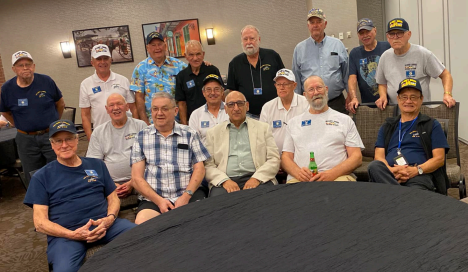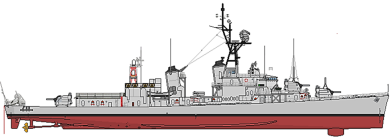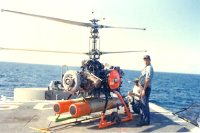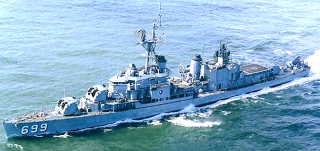October 8 2024 
Hubbard Shipmates Wrap up New Orleans Reunion Ahead of Hurricane
Gathering in New Orleans for the USS Harry E. Hubbard (DD-748) annual reunion were 24 shipmates and 33 guests. For comparison the totals for the six previous reunions were 2023 Orlando 20 and 31, 2022 San Diego 25 and 33, 2021 Milwaukee 19 and 36, 2019 Nashville 38 and 62, 2018 Newport R.I. 33 and 52 and 2017 Oklahoma City 41 shipmates and an unknown number of guests. There was no reunion in 2020 due to COVID. Attendance in the years since COVID has been markedly smaller than the three years before.

Some of the shipmates decided it was time for a group picture just after the Silent Auction. In the picture above, left to right seated in front: MM3 Terry Cloud 57-59, MM3 George Young 62-66, MM3 Tom Ornazian 68-69, MM2 Jim Stromberg 67-69 and MSCM Ed Jose 67-69. Seated behind them are: BM2 Dick Martin 68-69, ICC Dennis Ditsch 68-69 and MM1 Doug Leland 66-69. In the back row standing are: RD2 Gary Padgett 63-66, reunion host CDR Jim Kelly 66-68, SM1 Karl Hudson 57-59, SK1 Dave Majeski 67-68, LT Dick Oliver 68-69, SFP3 Jimmy Loy 68-69, FT2 Otto Brock 1956-57 and SH3 Al Eisenbraun 65-67. Absent for the picture: LTjg Ed Blanchard 64-67, LTjg Bill Carter 63-66, MM1 Tom Cunningham 52-55, LTjg John Duffy 64-66, MEG3 Vern Fairchild 55-57, SN John Fried 59-61, LT Brad Howe 64-67 and MM2 Hank Schleider 67-69. They were perhaps out enjoying the fine cuisine of New Orleans.
Wives, family members and other guests: Debby Adema, Donna Allen, Ray Brock, Rita Brock, Ruthe Cunningham, Mary Davis, Susan Fried, Lee Gordon, Ely Jose, Eugene Jose, Beverlee Kelly, Dorothy Leland, Chuck Leland, Ken Leland, Randy Libbey, Patty Libbey, Elfriede Lesnick, Erica Majeski, Renae Majeski, Mary Martin, Melanie Niedens, Natalie Oliver, Celia Padgett, David Padgett, Ken Padgett, Irene Phenice, Margarita Rodriquez, Jerry Rogers, Lisa Sanders, Diana Stanton, Brenda Terry and Cherry Young.
The New Orleans reunion was September 22-26 2024, wrapping up on a Wednesday night. Thursday was a travel day for most. LatenThursday Hurricane Helene came ashore in the Big Bend area of West Florida south of Tallahassee. John and Susan Fried, resident of The Villages in Central Florida, left a day early. Natalie and I decided to drive East on I-10 non-stop and take refuge in Jacksonville rather than drive into the storm headed for home in St. Petersburg. The Youngs encountered some power outages and high water heading home to North Augusta S.C. The Joses reside in Orlando and drove. The Ornazians live in Port St. Lucie and flew home. Thankfully none of us lost homes. Hope that is true of all our shipmates throughout the South. We have a total of 20 shipmates residing in Florida. At this time we do not know of any problems. Hurricane Melvin came ashore in Florida in early October with more disruption. If we ever have a Florida or Gulf Coast reunion again it will need to be in the Spring or early Summer.
Brad Howe volunteered to hold the 2025 reunion in New England. He will be assisted by Ed Blanchard and John Duffy, who also reside in New England, and by Bill Carter. The four were junior officers aboard Hubbard in the interval 1963 to 1967. We will attempt to let everyone know of the dates as soon as they are determined but will wait for tour and hotel information before mailing a newsletter to our full mailing list. Many shipmates and associate members are receiving the newsletter on our website, www.dd748.org, via Facebook or as an enclosure to an email. Those who have contributed to the newsletter have the option of a printed copy. With fewer copies being printed we can use color pictures and print on a home copier machine while still saving money.
The financial report as delivered by Dick Oliver, Treasurer: Report in August 2023 newsletter showed a balance of $1359.21. Receipts were donations of $1250 and ship store sales $462.35 for a total of $1712.35. Expenses were Orlando reunion $511.75, flowers $435, postage $770 and envelopes $26.74 for a total of $1743.49. Balance as of this newsletter is $1328.07 for a net loss of $31.14. All present bills have been paid, though we can expect to have some money spent on flowers and memorials as we lose shipmates. Reunion host Jim Kelly indicated a positive balance from the New Orleans reunion and Al Eisenbraun indicated he will be sending in the ship store profits from sales at the New Orleans reunion. So, overall, we are in good shape. The plan to hold the memorial service at the popular National World War II Museum during our tour on Wednesday did not work out as the cost was more than we were willing to pay. Instead it was held at the hotel, back to back with the business meeting. Included in our attendees was Irene Phenice, whose husband BT3 Kevin Warren Phenice served aboard 1966-1969 and died 11/19/2023 in Hemet California. The complete memorial list follows: MM2 Frederic Melvin Alexis FN 1959 b. 8/2/1937 d. 9/13/2023 La Grande Oregon; RM1 Maurice Wilhelm (Andy) Andersen, Jr. 56-60 b. 2/21/1921 d. 1/4/2016 Brisbane Australia; QM3 James W. Bowman 52-54 b. 10/19/1931 d. 9/13/2023 Cedar Falls Iowa; BM1 Bobby D. Crosswhite BM3 59-61 b. 6/27/1929 d 6/7/2022 Daleville Alabama; LCDR Charles M. Dallas LT 56-58 b. 11/25/1926 d 5/5/2022 Cherry Hill New Jersey; SN Delbert Lee Fraser 63-65 b. 1/20/1945 d. 5/17/2015 North Bend Oregon; BMSN Philip Stephen Hager 66-68 b. October 1946 d.May 2013 Las Vegas Nevada; BTC Robert Lee (Bob) Harrison 50-52 b. 9/4/1928 d. 9/18/2023 Oak Harbor Washington; YN3 Edward L. (Ed) Jackymack 56-58 b. 1/20/1939 d. 3/8/2024 Dearborn Heights Michigan; CSSN Larry Johnston 65-66 b. 12/16/1946 d. 8/17/2024 Cuyahoga Falls Ohio; BT1 John Edward (Jack) Kelly 56-59 b. 8.27/1933 d. 6/13/2021 Fairfield California; FN David H. Krouse 58-61 b. 5/18/1939 d. 2/15/2013 Bossier City Louisiana; RD2 Jon Richard (Dick) Marshall 61-62 b. 10/29/1935 d. 10/25/2023 Orland Park Illinois; EMP2 Frank Victor Miller 50-52 b. 9/4/1925 d. 7/12/2023 Roseville California; SN Denver Lee Nimmo 62-64 b. 9/16/1943 d. 3/18/2024 Tulsa Oklahoma; BT3 Kevin Warren Phenice 66-69 b. 10/28/1947 d. 11/19/2023 Hemet California; RD3 Raymond Clarence (Ray) Rexroat 65-67 b. 12/19/1946 d. 10/6/2023 Grimes Iowa; DC1 Rodney L. Schossow 62-66 b. 1/22/1933 d. 2/2/2022 Bend Oregon; FN Donald E. Smith 56-59 b. 3/2/1939 d. 1/26/2024 Ft. Wayne Indiana; FTG3 Dale William Smolnisky 62-65 b. 5/6/1943 d. 3/16/2024 Litchfield Minnesota; RM2 Thomas Joseph Stalcup 59-62 b. 8/13/1940 d. 10/5/2023 Drumright Oklahoma; Cdr. John E. White 56-58 LT b. 8/7/1930 d. 6/12/2024 Columbus Ohio; RM3 Zale Kay Wood 57-58 b. 8/25/1937 d. 3/7/2023 Zillah Washington; GM3 Joe Tom Wright 51-54 b. 12/15/1930 d. 1/1/1956 Floresville Texas.
Since the reunion we have learned of the death of LTjg Eugene Francis Gerwe, 1952-5, who died 3/19 2024 in San Jose California. He was born 10/3/1930.
We don’t have any new members this cycle but we do have new addresses for several with whom we had lost contact. They probably moved and we did not receive any change of address either from the individual or from the post office. Many people rely on the post office to do the task but often it fails. On the plus side we have several previously “lost” shipmates with whom we are reconnecting. These are: SFP3 Larry Mick 68-69 in Texas, IC2 Victor Frolich Jr. 56-58 in Arizona, FTG3 Robert G. Gilbreath 63-67 in Montana, MM2 Jack McKenzie 63-66) Colorado and SK1 Jack Brannan 64-67 in Louisiana. Jack said he last received a newsletter when he moved seven years ago. We have fifteen more lost shipmates, some of whom are likely deceased.
In the group picture several shipmates are wearing new gear Al Eisenbraun produced just in time for the reunion.

He was tracking down the postman as he was still packing for his early morning flight from Seattle to New Orleans. You will find the merchandise listed on the website or you can call him and ask for a flyer. He is always happy to talk to shipmates. This is a good time to mention that he has a new phone number. He is finally ditching the expensive landline and using only his cellphone. You can reach him at 425 876-7272. Remember he is on the West Coast and adjust your phone call time accordingly.
Thanks to past donors to this newsletter, particularly those who have not been able to attend a recent reunion. Here are some of those who have requested and are supporting a printed version of the newsletter. BMC Benson Ackerman 61-64, EN2 Lawrence A. Alfonso 59-61, TN Percy Burnley 54-58, SMSN John F. Byers, Jr. 58-61, LCDR Jim Chester 1969, GMM2 Claud Arlen Cluster 59-60, HMCS Kenneth Jack Cole 63-65, GM3 Julian P. Dove 51-55, BT3, Gene Konkoski 57-58, BT2 Perry Massey 67-69, Capt. Harv McKelvey 63-66, BT2 Ron Morefield 66-69, PC3 Jim Nordin 65-66, FT2 Ken Shrock 51-54, BT3 Wayne Sundberg 61-62, BT2 George Swift 61-62, ETN2 Joe Szijarto 68-69 and Capt. Dick Williams 66-67.
This article was written by Dick Oliver, editor of Hubbard Herald since June 2001 when he began the newsletter to promote reunion attendance. The name Hubbard Herald dates from 2006. In 2011 the distinctive logo with the lightning bolts was copied from the newsletter printed aboard ship in WWII. I think it was mimeographed but it might have been dittoed. Hubbard, of course, never had conventional printing press. Thanks to shipmate Shane Hayes for another contributed article. We welcome contributions in any form. I will help you with spelling, grammar and suggestions while trying to preserve as much of the original as will fit. Dick Oliver
A Helicopter on the Hubbard?
Contributed by SK3 Shane Hayes 1968-69
Can you imagine landing a helicopter on the Hubbard?
The obvious question would be: WHERE?
Straight out of bootcamp at 19 years old reporting aboard Hubbard, R & R (aka I & I) held much more interest for me than what class of destroyer SECNAV had randomly plunked my butt on. My fairly quick transition from deck force to storekeeper striker didn’t really leave much room for “nautical” or Navy type thoughts. Fifty-five years after the fact, out of the blue one day I decided to investigate Sumner-class destroyers.
Allen M. Sumner Class (58 Ships) Before the first Fletcher destroyers were in service, the Navy ordered a different design to sport more fire power. The Sumner Class carried the following armament: six 5” dual-purpose guns in three double mounts, ten 21-inch torpedo tubes, one depth charge rack, twelve Bofors 40mm (anti-aircraft autocannon) and eleven 20 mm Oerlikon anti-aircraft guns. Speed: 34 knots, Range: 6,000 nautical miles, Crew: 336-363 officers and enlisted.
The internet quickly informed me the first of 70 Sumner-class destroyers was laid down in May 1943, while the last was launched in April 1945. Twelve were refitted for mine laying, changing their classification to DM in 1944. Of the remaining 58, four were sunk in WWII and one severely damaged. The USS Seaman was never completed, lost her bow to fix the USS Collett DD-730 that was damaged in a collision with USS Ammen DD-557 in August 1960, killing eleven of Ammen's crew.)
The 53 other Sumner hulls were almost identical to the Fletcher class except for a one foot wider beam and having twin rudders, giving them better maneuverability for ASW work (Anti-Submarine Warfare). Yet topside, things were considerably different. They were the first U.S. Navy destroyers designed with a Combat Information Center (CIC) and they had a larger bridge area.
Sumners achieved a 20% increase in 5-inch gun armament and almost a 50% increase in light AA armament on a hull about the same length as a Fletcher. Upgrading with new weaponry required added electrical power; solved by increasing the generator size with the side benefit of creating extra emergency power. A larger crew meant greater demands for a second evaporator. All this added weight to the basic Fletcher hull came with a cost of being 150 tons heavier, about 15 inches deeper in draft and three knots slower.
By 1960, the Navy launched a program to extend the lives of WWII era destroyers by shifting their mission from a surface attack role to that of a submarine hunter-killer. Dubbed FRAM. (Not FRAM oil filters that extend the life of your car). Aptly named, Fleet Rehabilitation and Modernization, 33 Sumners were chosen for the conversion. Alas Hubbard was not one of them. Those “tin cans” gained the new moniker of “FRAM cans.”

Admiral Arleigh Burke, (aka "31-knot Burke" for his exploits as a destoryer squadron commander in WWII); started the FRAM program as a response to the Soviet Navy building submarines at a breathtaking rate (estimate 300 modern fast-attack submarines by 1957). Burke oversaw preparation of a congressional report entitled "The Aging Fleet." FRAM aimed to fill the gap until new ships could be built.
Cause and Effect – “Modernizing” A large portion of the Sumner fleet would utilize a highly innovative sub-hunting drone helicopter able to vertically takeoff and land called the Gyrodyne QH-50 DASH to deliver torpedoes. Landing a helicopter on a destroyer required “Fleet Rehabilitation” by creation of a landing pad, hanger, new onboard systems, training and education.
Profile of USS Allen M. Sumners 
DASH conversion profile (Note area from
fantail to aft smokestack & radar tower)
Homeported in Long Beach, the USS John W. Thomason (DD 760) was utilized as a prototype for the first Sumner FRAM/DASH conversion beginning in 1961. First the rear deck became a flight deck for the DASH, then a hanger appeared; new 12.75-inch triple torpedo tubes (for MK-44 acoustic homing torpedoes to attack submarines with higher speeds and greater operating depths) were placed where the older 21-inch ones had been. Two compatible new 21-inch torpedo tubes for the Mark 37 ASW homing torpedo (for targets with speed lower than 20 knots (37 km/h) and depth less than 1,000 ft (300 m) were added. Other enhancements: New air search and variable depth sonar (VDS), height and surface radar; plus many improvements in living and working spaces as well. All three 5/38 twin gun mounts were retained, while six 3-inch guns were removed. Cost $4,500,000 per ship.
Typical FRAM conversions extended the life of a destroyer by about five years. The first system was deployed on board the USS Buck DD-761 in January 1963. President John F. Kennedy watched a successful demonstration of a DASH dropping an exercise torpedo on a target later that year. Many of the ships provided significant gunfire support in Vietnam.
DASH helicopter with MK-44 homing torpedo It's stunning to realize just how far ahead of it’s time unmanned technologies like DASH (Drone Anti Submarine Helicopter) truly were. WWII destroyers didn’t have the deck space for a full-sized helicopter and their onboard weaponry had its limits. With FRAM upgrades the DASH helicopter had a 22½ mile ASW kill range, helping Sumners to remain relevant. Although simple in concept, the diminutive DASH QH-50′s really did represent a large force multiplier when it came to America's rapidly evolving ASW capabilities and vastly increased a dated destroyer's "sphere of engagement."

The little unmanned helicopter weighed well over a ton fully armed, cruised at over 50 knots and sported a counter rotating rotor system (coaxial), which eliminated the need for a complicated tail rotor, while also reducing the craft's "footprint". DASH had the ability to haul a pair of MK-44 acoustic homing torpedoes, or an MK-17 nuclear mine (yes nuclear!). A fairly simple idea: once the ship's combat information center (CIC) detected a hostile Russian sub within its midst, the little drone would fly out to the point of detection and unleash its deadly payload. Usually launched at a 100 ft. altitude, when the torpedo hit the water, it began a spiral search pattern for target acquisition. The hunted sub would have little early warning before the torpedo splashed down into the water and began its terminal attack phase, or if the nuke was utilized, its chances of survival were almost nonexistent. DASH was special in that it could be recalled if the target turned out to be friendly, plus it was reusable.
In Long Beach, you may have seen a couple of FRAM destroyers: the USS O’Brien DD-725 or USS Walke DD723. Those Sumners without FRAM standoff ASW capability, like Hubbard, were decommissioned 1970 - 1973. Some served in the Naval Reserve Force (NRF), remaining in commission with a partial active crew to provide training for Naval reservists.
FRAM destroyer USS Walden DD-699

Executive Board and Contact list
The USS Harry E. Hubbard (DD-748) Reunion Association is governed by an elected Executive Board. Chairman is Jim Kelly, email jimkelly@earthlink.net Tel. 323 254-0837 (Pacific time zone). Vice-chairman is Doug Leland, leldd0645@outlook.com, 417 859-2202 (Central time zone). Other board members are Tom Ornazian, Russell Miller and Jim Stromberg. Alternates are John Fried and Bob Chavez.
Point of contact for the website, ship store and shipmate location is Al Eisenbraun 748hubbard@gmail.com 425 876-7272 (Pacific time zone). Both email and phone number have recently changed so be sure and update your contact list.
The newsletter editor is Dick Oliver. Postal address is 199 Dali Blvd PH-3, St. Petersburg FL 33701-3663. Email is dd748@mac.com. Phone is 727 363-3059. Please leave a message and he will call you back. Since his phone and email are posted on the internet and elsewhere, he gets a large volume of nuisance and junk mail and phone calls. He is also treasurer. Contributions to the newsletter by check may be made out to the USS Harry E. Hubbard DD-748 Reunion Association.
While we have had to minimize phone, email and street address information because of bad guys and scammers, we remain dedicated to helping shipmates connect with each other. That includes tracking down any shipmate you may inquire about. Our extensive files include nearly every person who ever served on Hubbard, including reservists. Most of the shipmates have not been located. Those known to be deceased are shown on our memorial pages on the website. Al and Dick and the board members are dedicated to connecting crew with each other. Don’t hesitate to call, email or write.